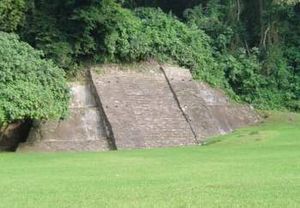- Cuyuxquihui
-
Totonac culture - Archaeological Site Name: Cuyuxquihui Location Paso de Correo, Papantla, Veracruz
 Mexico
MexicoCoordinates 20°18′17.83″N 97°15′43.94″W / 20.3049528°N 97.2622056°WCoordinates: 20°18′17.83″N 97°15′43.94″W / 20.3049528°N 97.2622056°W Culture Totonac – Tepehua Period Postclassical Foundation Around 1,250 CE. Decline Final Postclassical Language Totonac INAH Official Page Not available Cuyuxquihui is an archaeological site located in the Tecolutla valley, in the region of the Totonac culture, about 14 miles (22 kilometers) southeast of El Tajín, two kilometers from the “Paso de Correo” town, in the Veracruz State, Mexico.
The name of Cuyuxquihui is a composed word from the totonaca language; cuyu, armadillo and quihui, wood and it points to the similarity of the local fauna to the shell of that animal.[1]
“Totonaca” also is an Administrative Region in the Veracruz State, includes the Tecolutla valley and it is rich in prehispanic archeological sites, presumably constructed by the Totonacs, which lived next to the sea. The Tajín is one of those settlements.[1]
This site it is about 74.29 kilometres (46.2 mi) southwest from Las Higueras (archaeological site), another Totonac site in the region.
Contents
The Totonacs
The Totonac Culture, whose name is possibly translated as "three hearts", likely referring to three centers of this culture:
- El Tajín (300-1200), maximum exponent of the totonacs culture splendor
- Papantla (900-1519).
- Zempoala (900-1519).
This culture had a large ceramic variety and stone sculpture, monumental architecture and cities with an advanced urban concept. The Totonac Languages are a family of closely related languages spoken by approximately 200,000 Totonac and Tepehua people in the states of Veracruz, Puebla, and Hidalgo in Mexico. The Totonacan languages are not demonstrably related to any other languages, although they share numerous areal features with other languages of the Mesoamerican Sprachbund, such as the Mayan languages and Nahuatl.
The site
 Cuyuxquihui Archaeological Site
Cuyuxquihui Archaeological Site
This settlement would seem to have been a fortress, due to some architectonic characteristics; the existence of retaining walls that run throughout the esplanade north to south has been confirmed; its height makes it relatively inaccessible from the west, as well as by the cliff that borders it to the east. It is believed it was required due to the large social mobility that ensued after the fall of Tajín.[1]
Material remains on the various regional settlements, leads to believe that a good part of them were El Tajín contemporaries and that some developed after its gradual abandonment. Evidence seem to indicate that the Cuyuxquihui settlement was founded in 1250 CE.[1]
Cuyuxquihui developed, after the El Tajín decline, as an important ceremonial activities center. Diverse structures were constructed by means of ground surface leveling, construction element characteristic of the “Tajín Chico” site. The first constructions used selected materials, which were applied with mortar elements and subsequently were finished with gross stucco and painted.[1]
Cuyuxquihui was conquered by the Aztecs, Moctezuma Ilhuicamina[2] (1398 – 1469) towards 1465, probably one of the most important reasons of the cultural mix of the totonac elements, mexicas and huastecos.[3]
Structures
Most important buildings:
Building 1
This is a four bodied pyramid and a small vertical wall; remains of blue and red paintings were found on it. Objects found on this building are: a knife, fine ceramics and tablets with Quetzalcoatl engravings, indicate that the building was used for ritual functions.[1]
South Building
This structure is considered the oldest in the site.[1]
Building III
At the top of this structure, a two meter high monolith was found, it has evidence of having been re-modeled in three occasions; the last one, with Aztec influence occurred in 1400 CE.[1]
Buildings IV and V
The structure is also called “dos unidos” (two jointed); in the top both have a small platform, over which probably was another construction, that is not there anymore.[1]
Ballgame Court
The court is “I” shaped and measures 72 meters long by 4 wide, it was constructed on a topographic accident.[1]
References
- ^ a b c d e f g h i j "Cuyuxquihui [Ditto]" (in Spanish). http://portal.veracruz.gob.mx/portal/page?_pageid=313,4309079&_dad=portal&_schema=PORTAL. Retrieved Sept. 2010.
- ^ Huehue Moctezuma or Moctezuma I El Viejo (The older) (náhuatl: Motēuczōma Ilhuicamina, "Su Señor el Airado, Flechador del Cielo") was the fitfth huey tlatoani or Mexica emperor (1440 - 1469).
- ^ Cháirez, Arturo (febrero 2000). "Guía No. 56 Veracruz [Veracruz Guide 56]" (in Spanish). Mexico Desconocido. http://www.mexicodesconocido.com.mx/notas/6953-Cuyuxquihui-(Veracruz). Retrieved Sept. 2010.
External links
Categories:- Mesoamerica
- Mesoamerican sites
- Archaeological sites in Mexico
- Archaeological sites in Veracruz
- Totonac sites
Wikimedia Foundation. 2010.


